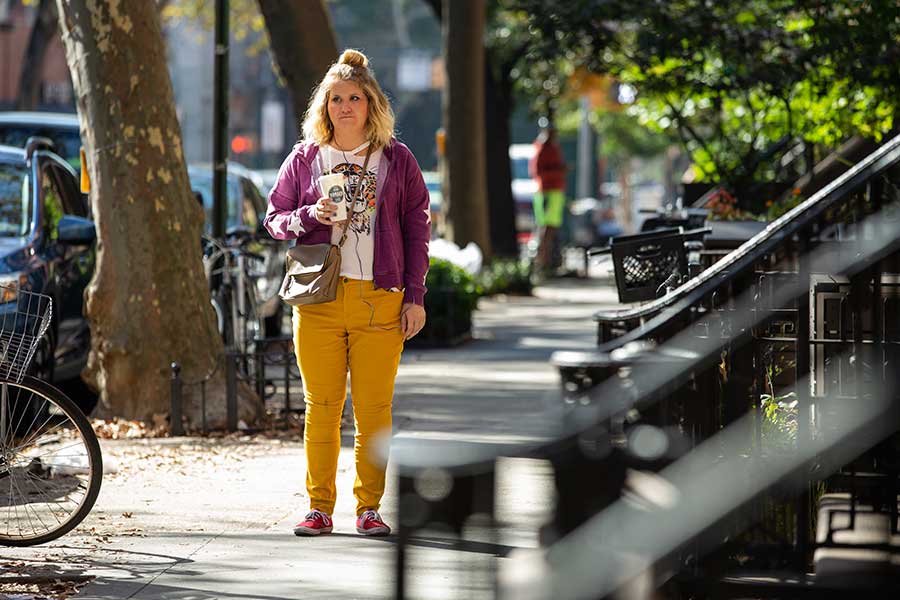“Brittany Runs a Marathon” is out gay writer and director Paul Down Colaizzo’s appealing comedy-drama.
The film, opening August 30 at the Landmark Ritz Five, concerns the title character (Jillian Bell), a Philadelphia native, who is broke and almost 30. Living in New York, she decides to take charge of her life by joining her neighbor Catherine’s (Michaela Watkins) running group. It is there she meets Seth (Micah Stock), a gay man, and the trio convince themselves to run the New York City Marathon.
As she trains for the race, Brittany gains a sense of self-confidence. She also embarks on a relationship with Jern (Utkarsh Ambudkar).
In a recent phone interview, Colaizzo spoke with PGN about his warmhearted film, admitting that he is no runner himself, “I could never run. I have bad ankles, and standing on the set of the film, my ankle pain was so bad, that after the film I had surgery on my ankles. Now, I’m a half inch taller!” But Colaizzo did compete in a marathon of sorts, writing and directing his first feature, getting it into Sundance, securing a major distributor (Amazon), and getting a theatrical release.
He observed, “The tacky line is the whole thing is my marathon, and I’m almost done. I hope we cross the finish line well.”
The filmmaker based his idea for “Brittany Runs a Marathon” on his best friend. His intention was to put a character who is often a sidekick or seen as comic relief in films at the center of the story.
“The goal of this was to take a ‘hard partying’ character and allow her to be seen with dimensions and layers and desires. I wanted to ask audiences for empathy and sympathy. Make her the everyman and give her the hero’s journey.”
Colaizzo’s intention is to make viewers think about perceptions of themselves, but also how they are seen in the eyes of others. As the film shows, Brittany’s initial impressions of Catherine and Jern are critical, but she comes to appreciate and embrace them as she comes to know them. Likewise, Brittany’s friendship with her roommate Gretchen (Alice Lee) becomes strained once she starts training and cuts back on excessive partying.
While the film is comedic in its tone, Colaizzo generates much of the humor from what he calls, “character moments. There’s nothing broad or slapstick-y.” He explained, that the characters, “Use humor to deflect vulnerability. It’s humiliation and pain and embarrassment [humor] and the relatable experiences of wanting and longing. That’s the art of clowning. We are taking these clowns — and I mean clowns in the theatrical sense — who are funny, supporting players, and deepening all of them. We wanted to show the humor and joy, pathos and pain, and humanity. The three-dimensional experience of all the characters by making something funny and bright and inspirational.”
As for finding inspiration to make a change, Colaizzo admits he is as likely to go hard as he is to go back to bed. “Every day is a fight,” he declared, “What the film explores is that change comes in small steps. How we change is as important as what we change. Every day is a step in the right direction, but if you go in the wrong direction, it is still against bad behavior.”
The filmmaker grew up in Georgia, in a Catholic, Southern life. When he moved to New York, he re-examined who I was. He recalled, “I came out when my parents divorced, and I unpacked everything I was taught was a given. I recreated myself with my own values and rules. In having to re-examine myself and create the life I wanted, I had to change my behavior. Every day I’m still doing that. That’s what we all need to do in society. We live in a time without a lot of hope, and we’re afraid for the future, but we got here through change, and we can get out of it through change, too.”
Colaizzo spent part of his childhood in the Philadelphia area, and the film features a few shots and scenes set in the city. When asked about this, Colaizzo acknowledged, “I was born in Pittsburgh. Philly was the enemy — the other big Pennsylvania city. I lived in Voorhees, NJ when I was four to eight years old. We’d go downtown all the time, and my first memory was of the Liberty Bell. History is preserved in the life blood of the people — a feeling of comfort and camaraderie which is why I used Philly as a location. And it’s only two hours from New York. We stole the shots of the skyline. I paid a guy to let me break in and take them from his roof.”

